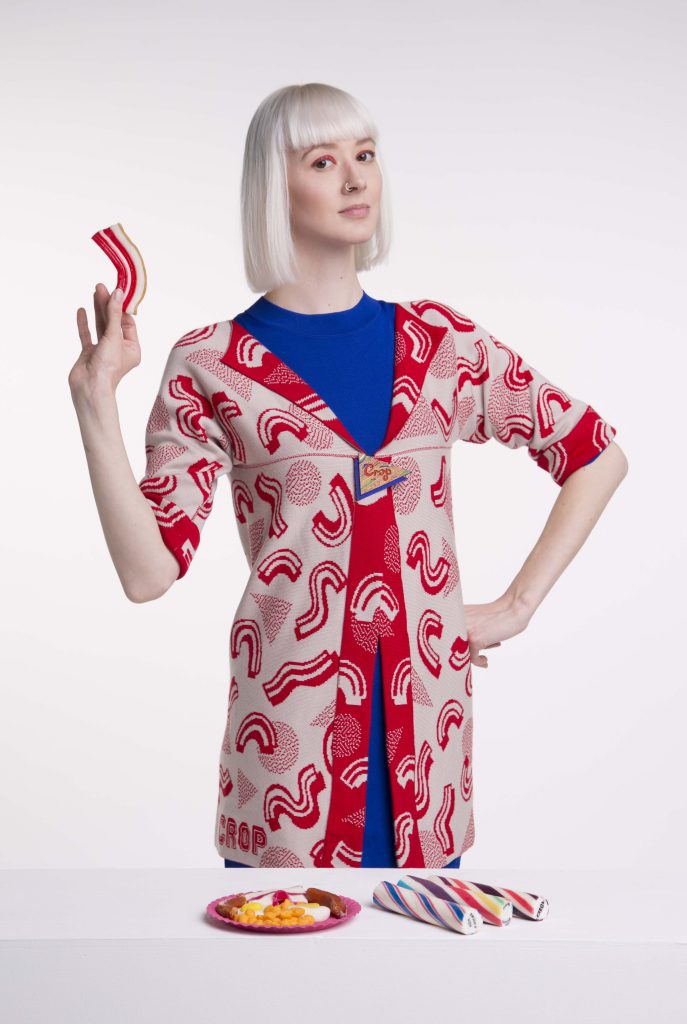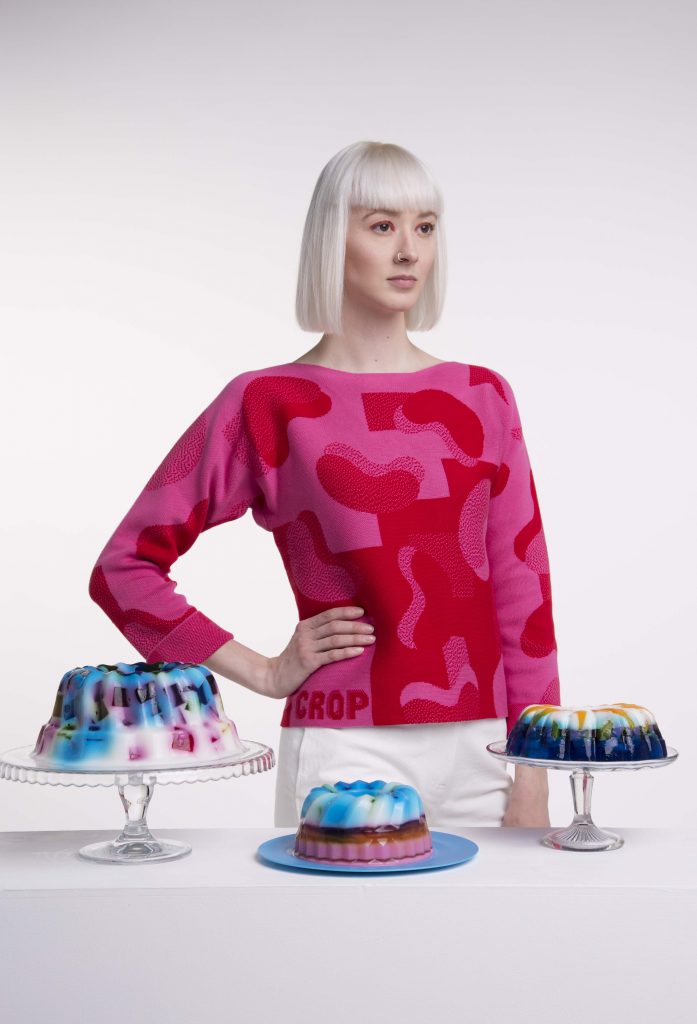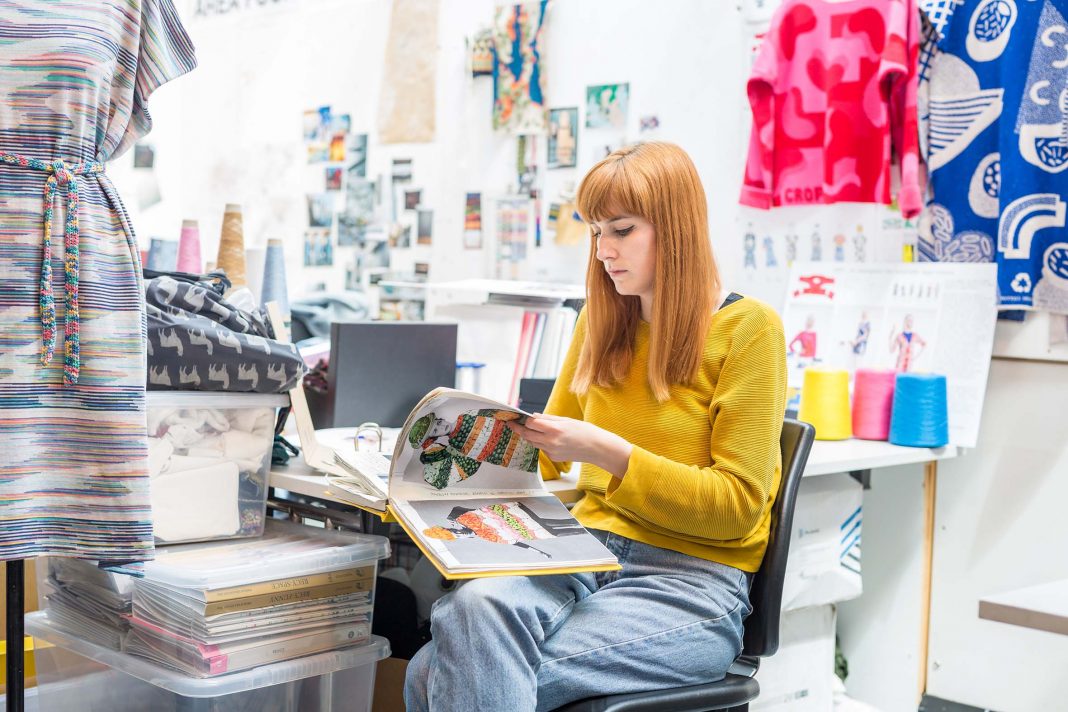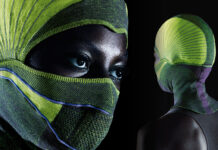This month, we spoke with Kate Morris, fine-artist turned knitwear designer, who last year set up her ethically and sustainably conscious knitwear label, CROP. Kate talks to us about the creation of CROP, winning EcoChic Design Award 2017, and working with new Hong-Kong based upcycling brand, The R Collective…
Can you tell us about your background and your reasons and desires for setting up your own label, CROP?

I originally trained as a fine artist with a hobby of hand knitting alongside. My creative drive shifted to wanting to produce functional items of beauty, so I decided to turn my hobby into my career. This coincided with the Rana Plaza garment factory collapse; this really awoke me to how critical the problems were in the fashion industry and I knew that I wanted to be a part of changing this.
I have always planned to eventually run my own business and after building up five years industry experience I decided to return to education spending a year on the MA Fashion Knitwear Design course at Nottingham Trent University coming up with the concept of CROP.

Model : Megan Turner-Jones
CROP was born out of my desire to provide happiness-inducing fashion that is conscious, cruelty-free and cheerful. After extensive research into the global needs and beliefs of today’s generation I was led to the fast growing movement of vegan fashion. I wanted to fill a gap in this market for knitwear that has an equal focus on environmental and social impact as well as animal welfare – the majority of vegan knitwear currently on offer is in synthetic fibres
Why ‘CROP’?
The name CROP comes from the brand’s core ethos of only using plant based fibres. CROP intends to break expectations with vegan knitwear that can be worn across multiple seasons.
I selected commercial yarn with minimal carbon, chemical and water footprints choosing the super skin friendly fibres of organic cotton, bamboo and tencel for my MA collection.

It is also my intention to ‘CROP’ out any unnecessary waste in the production process. As well as being fully-fashioned I also incorporate minimal seam elements into my designs. Each of my garments are made in single pattern pieces with a focus on increasing production efficiency and longevity.
I’m interested in the idea that less seams mean less chance of holes, less unnecessary labour, increased comfort and easier deconstruction at the very end of a garments life.Re-thinking where to put the seams has led to relaxed fit, inclusive silhouettes that can be subtly adapted by the wearer. I have also tried to consider the full life cycle of the garments; the care labels have been knitted into the jacquard patterns promoting low impact use and disposal and I have used only one fibre type per piece to aid eventual recycling.
You recently won the EcoChic Design Award 2017. Can you tell us about your EcoChic journey?
The competition brief was to create six outfits made completely from textile waste. I submitted designs for a knitted collection made from ex-industry end-of-line cones of yarn as well as strips of discarded t-shirts. After being selected as the UK finalist, I was given ten weeks to source the waste, develop, and produce the collection. All ten finalists from around the world then met in Hong Kong for a whirlwind-week of design challenges, networking and promotion, facing a judging panel of industry figures, and ending with the grand final catwalk show during Hong Kong Fashion Week – all filmed for TV documentary ‘Front Line Fashion’.

The concept behind my EcoChic collection was technology and hand-craft working together in harmony. Part of the collection was made on Shima and Stoll machines, that I then worked back into with hand-craft techniques like crochet, embroidery and smocking. Other parts were hand-knitted from strips of yarn cut from discarded jersey t-shirts. I intend the crafted elements to inspire people to get making, reusing and mending.
Following your award from EcoChic, you spent 3 months in Hong Kong designing a capsule knitwear collection for The R Collective. Can you tell us a little bit about The R Collective and what you did with them?
The R Collective is a new Hong Kong based upcycling brand that uses top brand’s surplus luxury materials to make beautifully designed and crafted clothes. It was born from a ten-year foundation of sustainable fashion research from charity Redress (who run The EcoChic Design Award). I was chosen to launch their first knitwear line working with the surplus yarn stock of luxury supplier Fenix Fashion (within Li & Fung).

The unisex capsule collection fuses my playful pop art aesthetic with timeless, wearable silhouettes through a diverse range of stitches including reversible jacquards and plated ribs. It will be available from www.thercollective.com at the end of January as well as instore at Lane Crawford – Hong Kong’s most iconic department store.
Working with The R Collective opened up my eyes to the sheer scale of surplus yarn stock that accumulates through current manufacturing systems. We were working with perfect-condition, extremely luxurious yarns that were considered waste as the result of brands changing their minds after sampling a dye lot, cancelling or miscalculating orders, and the diversion of replicating the same colour across two seasons.
Designing for The R Collective gave me a valuable insight into designing for the Asian market, allowed me to apply my researched design approaches into industry and learn a great deal from visiting and working very much directly with Chinese factories.
From Hong Kong, you flew straight out to Japan to work with Shima Seiki following your winning design in the Shima Seiki Student Design competition 2017. Can you tell us about your experience there?
I feel incredibly lucky to have won the prize of two weeks further training on the Shima Seiki SDS-One Apex 3 Design System at their Japanese headquarters. It was a very valuable experience to have such thorough training in everything this software is capable of. I had only gained an overview of the system during my MA course and to study it in-depth with the absolute experts was very eye-opening. I am completely amazed at the virtual sampling abilities of this software and its ability to cut out waste at sampling stage. I learnt how to produce incredibly realistic simulations of designs that determined the exact yarn texture, tension, drape and fit without wasting any time or materials. It also helped me expand my understanding of seamless knitwear construction and how Wholegarment designs are planned out.
The headquarters in Wakayama are the birthplace of the Shima Seiki knitting machine, include the knitting machine factory and have over 1000 staff. It felt like the ultimate knitting machine mecca, I even went to the Shima museum on my day off!
Shima were hugely hospitable during my stay and I continue to be in awe of what a hardworking and forward thinking company they are. My time in Japan, which I ended with a visit to Tokyo, was hugely inspiring and I feel this experience and training has made me a more well-rounded designer.
You must have gained some wonderful insights and knowledge through your Crop journey and time in the Far East? What have you found to have been the greatest challenges for creating your product?
The biggest challenge for me is that right now in the industry, applying sustainable design practice often means that the product inevitably becomes a luxury, exclusive one. Upcycling materials that are considered waste is one way of cutting costs and immediately prevents landfill. However, the scalability within upcycling can have its limitations and producing small runs often drives prices back up. A big challenge I have found with using upcycled yarn is forming a coherent colour palette but I also enjoy being guided by what’s available and I am not afraid of repeating colours across seasons.
What is your opinion on the Far East supply chain and where it sits on the topic of sustainability relatively?
I only saw a small glimpse of Chinese manufacturing, but I think in many respects manufacturers in the Far East can be at the forefront of change and have access to some of the best technology in the world to improve practises within the industry. I was really inspired by my visit to a TAL Apparel factory (who produce one in six shirts sold in the US) and learnt a lot from their sustainability team. They have committed to a lot of advanced measures at each stage of the supply chain to cut down on waste including virtual sampling and very clever pattern cutting software. Mass producers of this scale are more aware then ever of their impact and are in the position where they can invest in expensive measures to make a change.
In general terms, from what I saw in my time in Hong, sustainable shopping approaches are a lot less ingrained into the Hong Kong consumer. There are very little charity and vintage clothing shops and there is a lot of focus on constantly buying the latest trend. In terms of animal welfare, they seem incredibly behind which is a whole different issue all together.
Competitions like The EcoChic Design Award (from 2018 now called The Redress Design Award) are spreading awareness in Chinese universities resulting in new designers emerging with a focus on trying to change problems in the Far East supply chain. Working with The R Collective opened up my eyes to how open Chinese manufactures are to linking up brands with their surplus waste materials. Demand for more conscious fashion is growing slowly in Hong Kong and the fact that Lane Crawford is stocking my R Collective knitwear shows how much they believe their customer will connect with the collection’s story.
As a product, how and where do you think knitwear positions itself for sustainability? What are the positive impacts of knitwear as a product and what do you feel needs to change/be improved?
One of the biggest factors that attracted me to knitwear is that the process is in itself zero waste, everything can be shaped as it’s made and requires no cutting. The possibilities around seamless knitwear positions this product very highly in terms of sustainability. Knitwear has always been a product with great longevity which has been taken a step further by removing the points of weakness – seams. I continue to be fascinated by the labour-saving, production-efficiency and easy-deconstruction aspects of seamless knitwear.
I am weary of the many blends of fibres spinners are now pushing. Yes, blends meet complex, modern-day use requirements, and can contribute to lower-impact care, but they also cause great complications when it comes to disposal. I am interested in the idea that mono-materiality greatly aids recycling and responsible degrading processes. Developments in fibre recycling are changing at such a fast pace I am confident that this is an area that is greatly improving.
There are many complex issues surrounding wool and animal fibre-farming and production that I won’t go into here. A big concern of mine is the sheer scale of merino wool products the high street is pushing out at minuscule prices that has obvious negative effects environmentally, socially and of course on animal welfare.
What is next for Kate Morris, and CROP?
I am currently looking at working with Kniterate, a startup producing affordable compact digital knitting machines aiming to enable small batch production and local manufacturing.
I am still establishing a way of creating as transparent-a-supply-chain as possible and overcoming the huge initial costs of starting a fashion label. I am happy for CROP to grow slowly and look forward to collaborating with like-minded people along my journey.

Model : Megan Turner-Jones

Subscribe To Our Newsletter
Join our mailing list to receive the latest news and updates from our team.






